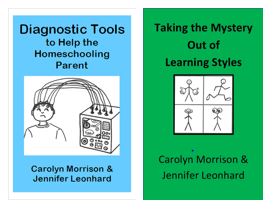My offer to write a series of articles on support groups and co-op classes is being well received: many of you would like to start support groups or expand your groups to offer a few classes. Some others, however, are new to both of these concepts and have asked for clarification — a good idea, since readers of this site cover all parts of the planet and local phraseology does not. I will attempt to define my terms, especially for our home education partners in Great Britain and Australia whose online journal entries can leave me puzzling over our common language. For those who have not experienced any of these efforts and for those who may have experienced them but called them by different names, here is what I mean.
Homeschool Support Groups consist of like-minded families meeting to encourage each other, share ideas, form playgroups, fellowship together through picnics or potluck dinners (each family bringing a couple of dishes to share with all other families), field trips, sports teams, etc. “Like-minded” in this case refers to families who participate in educating their children at home, regardless of which homeschooling method is used. Children can also be encouraging to each other, not just the adults, since all of the children share similar (though not identical) homeschooling situations. Some groups may wish to specialize further by focusing on a particular method such as “classical homeschooling,” “unit studies,” or “the Charlotte Mason method.’ [Groups may also wish to differentiate themselves by specific religious affiliation: Christian, Jewish, LDS, pagan, etc. More on this here.]
Co-op Classes are a cooperative effort among several families or a support group to supplement their children’s home education by working together on large group projects. These may range from simple to elaborate and may meet only once or on a regularly scheduled basis, but the topics covered should involve areas that are difficult to do at home with only one family. Some activities (such as knitting) are best taught at home with only a few students participating; others (team sports, for example) often do not work best in the home, needing a larger space or more participants to present the subject matter in the most effective manner. Cooperating with other families for certain endeavors can bring together a larger group of students while still maintaining the spirit of homeschooling. This is not forming a private school but applying homeschooling methods to a group larger than just one family.
Moms’ Meetings are monthly business meetings for the purposes of discussion, planning, fellowship, and sharing ideas. Nursing babies were always welcome in the groups I attended, but other children and Dads were occupied elsewhere, giving the mothers time to share each other’s burdens and offer helpful advice or plan future group events. Some meetings included devotional time or a member sharing a brief topical presentation of interest to the group (such as Motivating Reluctant Students). Meetings were usually held in the evening; some were held in homes (for a small group), while a rather large group met in a church meeting room. Refreshments were as varied as the members: some provided ice water only, others had multiple desserts, coffee, and tea. (Since many of us are often limiting our calorie intake and the meetings took place after the evening meal, simple beverages were usually all that was desired.) Note: I do not intend to offend or exclude the fathers who homeschool their children and often find themselves in the minority at group events almost exclusively populated by women. For simplicity, I have let the majority rule prevail.
Gym Nights required securing a local gymnasium for use by our group, and the Dads took turns organizing simple games for the children and supervising a period of playtime while the Moms were occupied at their meeting. Sometimes the older children were separated from the younger children (for safety’s sake), and outdoor activities were provided when the weather allowed. Other times the entire group was divided into balanced teams for games. My son was a big fan of “Capture the Flag,” a game where strategy was often more valuable than athletic prowess, and players of all ages and sizes could be valuable assets to their team. Since many Dads were present, there were always plenty of eyes to supervise little people and not just the one or two Dads who were in charge of planning that night’s events.
Field Trips mean going to a location for a tour or demonstration. Examples: arranging a visit to a bakery, printing shop, or small factory where the owner tells the children a little about running his business. [more ideas here]
Group Events may present the results of a class. Examples: art fair, vocal music performance, or drama performance. Other types of special events hosted by the group may include standardized testing, taking individual “school” photos, or a sports tournament. [more ideas here]
Any of these events may occur only one time, or they may be repeated on a regular basis — as often or as seldom as your group desires. I have participated with four different support groups; one group met twice a month for co-op classes and one evening each month for the Moms’ Meeting/Gym Night. Another group held one special event day per month, but did not do formal “classes.” I recommend planning each spring for the next year’s group schedule. Many families may want to work the group schedule into the theme of their own lessons, so advance planning is very important for them. I have heard of groups that meet once each week, but our curriculum plans would have made it difficult for us to participate weekly. As with all other scheduling, be sure you (the parents) are governing the schedule for your family, not in submission to it. Participate in events outside your home when they are convenient or beneficial to your family, but do not allow them to become more important than your family unity. When putting your family first, you are allowed to say “no” Guilt-Free.
Our April Moms’ Meeting was an idea session where we took suggestions for classes, events, and field trips from all members of the group. Then very dedicated planning committees (separate committees for classes & field trips) met once or twice during the next four weeks to organize the schedule and delegate responsibilities, and the final results were announced at the May Moms’ Meeting. One of the Moms had a friend who raised ostriches; she suggested a field trip to learn all about them, scheduled a date, and made the arrangements with the owner for a visit to the ostrich ranch. Another family had a son with a very successful hobby of raising tropical fish, and he offered to teach a two-session class on aquarium basics. (Students who taught classes got the added benefit of public speaking experience in a friendly, informal atmosphere.) Each family has something to share with the group, whether it is organizational skills or a hobby they can demonstrate. Ideas can range from a one-time, one-hour presentation to a semester of coaching drama rehearsals, culminating in the performance of a play.
Once I took up the challenge of working with another Mom to organize a very involved science-themed event that brought together families from four different support groups and covered homeschoolers in ten counties, a radius of approximately 50 miles. Response was so tremendous that we actually had to split the entire group in half and plan the two separate events simultaneously. It was a massive organizational triumph of multiple classes and field trips that came off nearly perfectly, but the grand scale was nothing I wish to repeat in this lifetime. The biggest lessons I learned from the undertaking were a) I am capable of much more than I had suspected, and b) never get involved in planning something with Mrs. I-can-do-it-all-and-more. (My daughter has reminded me to add c) how much I appreciate my daughter’s computer savvy for databases and spreadsheets!)
Now that you all understand what I am talking about, I will address deeper aspects of support groups, co-op classes, field trips, etc. While you are waiting for the next article to appear, you can begin brainstorming and write down your own ideas of things you would like to do with your own children or in combination with other families. Happy thinking!
[For more information on cooperative classes and group activities, visit Topical Index: Co-op Groups.]



 Guilt-Free Homeschooling is the creation of Carolyn Morrison and her daughter, Jennifer Leonhard. After serious disappointments with public school, Carolyn spent the next 11 years homeschooling her two children, from elementary to high school graduation and college admission. Refusing to force new homeschooling families to re-invent the wheel, Carolyn and Jennifer now share their encouragement, support, tips, and tricks, filling their blog with "all the answers we were looking for as a new-to-homeschooling family" and making this website a valuable resource for parents, not just a daily journal. Guilt-Free Homeschooling -- Equipping Parents for Homeschooling Success!
Guilt-Free Homeschooling is the creation of Carolyn Morrison and her daughter, Jennifer Leonhard. After serious disappointments with public school, Carolyn spent the next 11 years homeschooling her two children, from elementary to high school graduation and college admission. Refusing to force new homeschooling families to re-invent the wheel, Carolyn and Jennifer now share their encouragement, support, tips, and tricks, filling their blog with "all the answers we were looking for as a new-to-homeschooling family" and making this website a valuable resource for parents, not just a daily journal. Guilt-Free Homeschooling -- Equipping Parents for Homeschooling Success!

Recent Comments